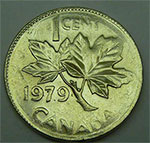Silver and gold coloured 1 cent coins
By thecanadiannumismatist | Monday, 24 July 2023
The process to give 1 cent coin a silver or gold colour is easy enough that there are many of them out there. Even if they are amusing to look at, these fabrications remain trivial and have obviously no value.
Dipped in zinc and sodium hydroxide, a copper 1 cent coin will turn to silver/grey. With heat, the silver colour will turn to gold.
This process was also shared in medias multiple times. Here is an example:
Video: Infoman, Radio-Canada, February 7, 2013. Don't throw away your old pennies
The same experiment can be done with tin instead of zinc. The alloy obtained is then bronze, of a different color, more pinkish.
Examples of plated coins from the community
Silver coloured 1 cent coins worth money
Because coins may be stuck in the feeding tubes, badly stored or any other reason during the production process at the Royal Canadian Mint, some planchets can be struck with a design from another denomination.
A 10 cents planchet, for example, struck with a 1 cent design can give a result in silver colour. This error is called Wrong planchet and was more frequent in the 70's (especially for 1 cent coins). These coins can be worth $50 to hundreds of dollars.
1 cent coins can also be struck on foreign planchets making them grey. The design on these coins is often badly struck, but not always.
Genuine penny or homemade plated coin?
There are some ways to tell if its a plated coin or a genuine one.
- X-ray fluorescence (XRF) test. Non-obstructive technique used to determine the elemental composition of materials.
- Scratch. By scratching the edge of the penny to see of copper is under the plating.
- Weight, size and magnetism. Comparing the characteristics of the cent with a genuine copper (or steel copper-plated) one.
- TPG. Sending it to a third party grading company to certify and authenticate it.
- Ask a collector. The discussions board is a great place to have more opinions of your coin if you provide pictures.
Related numismatic tools, articles and links
More articles
- Canadian coins
- Canadian banknotes
- Canadian tokens and medals
- International
You can submit your own articles by contacting us.












